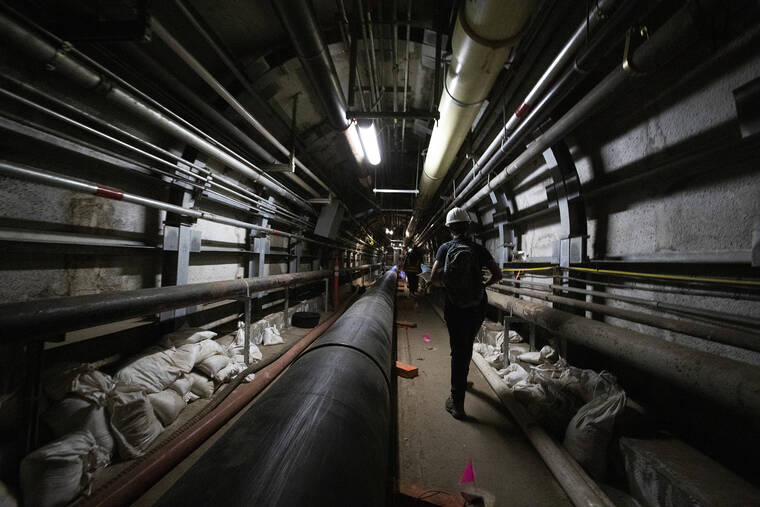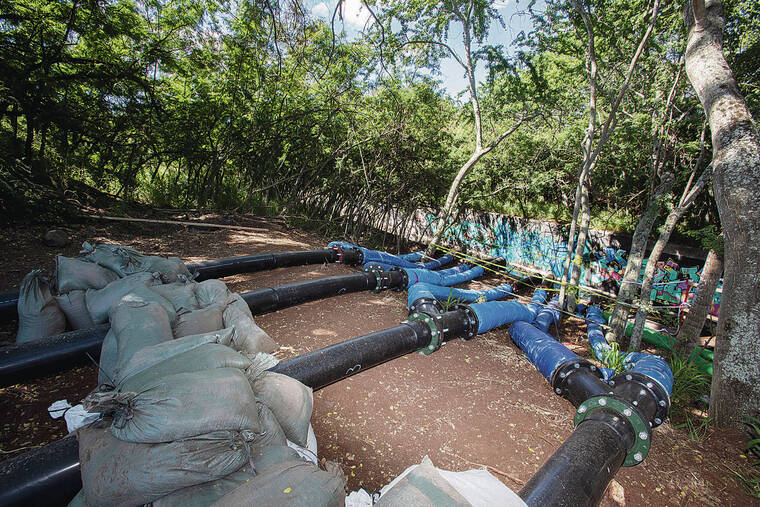The Navy continues to pump about 4.5 million gallons of water daily out of its Red Hill shaft in an effort to remediate the aquifer that was polluted with fuel from its Red Hill tanks in 2021. So far, roughly 600 million gallons of water has been pumped out of its well, filtered and dumped into Halawa Stream.
The amount is equivalent to the water contained in about 900 Olympic-size swimming pools.
That the Navy hasn’t found a use for the water, which it began pumping at the beginning of February, has frustrated state officials. DOH said that while there has been no indication that dumping the water into Halawa Stream has harmed the environment, it continues to urge the Navy to find a means to reuse it.
Hawaii Sierra Club Director Wayne Tanaka said the wasted water is “an affront to our public trust.”
The Navy, meanwhile, has been over-pumping its Waiawa shaft, its only remaining well that’s still connected to its water system. Following 2021’s fuel spill, it disconnected its Red Hill shaft and Aiea-Halawa shaft, to prevent fuel from further contaminating its drinking water system.
There is no projected end date for the pumping.
DOH said that until it can confirm that fuel is not migrating through the aquifer and doesn’t pose a threat, it will likely continue.
“We want to make it clear that all water resources are precious, but pumping from Red Hill shaft is the best option we have at this time to protect the aquifer,” said Matthew Kurano, an environmental health specialist with DOH’s Clean Water Branch, in written responses to questions.
In November, residents living in neighborhoods around Joint Base Pearl-Harbor Hickam began complaining of nausea, vomiting and skin rashes, as well as fuel smells coming from their faucets and sprinklers. Days later, water samples and a visual inspection of the Red Hill shaft found
it was grossly polluted with jet fuel. The Navy’s water system serves about 93,000 people, primarily military families.
In the months following the spill, Navy officials have said they think up to 19,000 gallons of fuel may have leaked from a pipe at its Red Hill fuel facility. But that figure hasn’t been confirmed, and DOH noted that it has yet to receive a conclusive report about the spill. That information could help determine what level of remediation of the aquifer may be needed.
Fuel contamination data analyzed by DOH earlier this year indicated that there was also a May 2021 release at the facility that made its way into the groundwater. Environmental officials also worry that historic fuel releases that date back to when the facility was built in the 1940s could also pose a threat to the island’s drinking water.
A spokeswoman for the Navy said that it has contracted with a company to conduct a water management study, which might look at water reuse issues and whether the water pumped out of the Red Hill shaft could be used to recharge the aquifer or for
irrigation.
Following November’s spill, DOH water samples taken from the surface of the well found levels of petroleum that were 350 times above the level the state considers safe. The Navy subsequently sent a team of divers down into the shaft to try to skim as much of the fuel that they could off the surface of the water.
In May a Navy official told the state water commission Opens in a new tab that the work was continuing and that there were still signs of contamination in the shaft.
The Navy did not respond to a question about whether it was still finding evidence of contamination in the shaft, but said it has employed skimmers, booms and absorbent pads to directly contain and remove fuel.
“The Navy, alongside stakeholders and community leaders, is working to prevent migration of contamination in the Red Hill well through fuel recovery, groundwater treatment, and other cleanup efforts in order to ensure the long-term health and sustainability of the Honolulu aquifer,” said a Navy spokesperson by email. “The Navy will continue to take proactive measures that will position it to make informed and environmentally protective longer-
term decisions, in coordination with regulators and stakeholders.”




